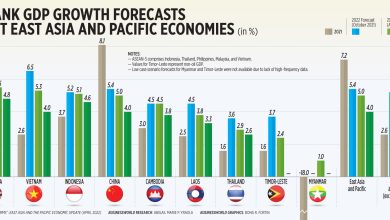First NFT insider-trading trial turns on art instead of stock

A FORMER product manager at the NFT marketplace OpenSea is set for the first-ever insider trading trial involving digital assets — and the object of his alleged crimes is pop art rather than stock.
Nathaniel Chastain, 32, was responsible for selecting which non-fungible tokens (NFT) would be highlighted. That usually led to an immediate spike in the price of the assets.
Prosecutors say that while OpenSea would keep the identity of featured tokens secret until they appeared on its home page, Mr. Chastain bought dozens of them beforehand and then sold them immediately afterward for as much as five times the purchase price, violating his duty to keep the information confidential.
Jury selection starts Monday in Manhattan federal court and the trial is expected to last one to two weeks.
NOT SECURITIES FRAUD
Most insider trading cases are centered around securities fraud, such as buying stock of a company ahead of a pending acquisition or merger based on information that was supposed to be kept secret, or avoiding losses by dumping shares of a drugmaker after learning about the negative results of a clinical trial before it’s announced to the public.
Mr. Chastain is instead charged with wire fraud, which allows prosecutors to avoid the thorny issue of whether or not an NFT is a security, a question that’s been hotly debated in the world of digital assets.
The government used a similar approach in the first insider-trading case involving cryptocurrency. Ishan Wahi, a former Coinbase Global, Inc. manager, pleaded guilty in February to two counts of conspiracy to commit wire fraud for trading on confidential information he learned about when the exchange was going to list new tokens.
Mr. Wahi faces as long as 20 years in prison on each count when he is sentenced next month, although he agreed to federal guidelines that call for him to serve 36 to 47 months behind bars as part of his plea deal.
A victory in the OpenSea case is likely to encourage further use of the strategy by prosecutors as a tool to ferret out fraud in nontraditional markets while regulations for digital assets are still being crafted.
Mr. Chastain has argued NFTs aren’t securities or commodities and therefore aren’t subject to the government’s theory — and that what he took isn’t misappropriated property, as required by the law, because it had no “inherent economic and market value and is based on the unspoken personal thoughts and ideas of employees.” He also contended that he didn’t commit money laundering because the transactions were done on a public blockchain.
‘MARKETING CONCEPT’
“A marketing concept, such as what should essentially be featured in an art gallery window, which has no determinable economic or saleable value and is based on an employee’s unspoken thoughts — regarding the mere selection of an item for prominent display — does not fit this bill,” Mr. Chastain’s lawyer, David I. Miller, said in a court filing.
A group of more than 300 defense attorneys filed a letter in support of Mr. Chastain’s request to throw out the indictment, saying that a finding that all “confidential business information” is property would “effectuate a breathtaking expansion of federal fraud and criminalize a broad swath of conduct never before thought criminal.”
“It would, indeed, capture virtually every instance of an employee using internal employer information for nonwork purposes,” the group said. “Wire fraud does not reach every employee who diverts ‘confidential’ information received at work to the employee’s own purposes.”
US District Judge Jesse Furman, who is presiding over the trial, rejected Mr. Chastain’s attempts to exclude the phrase “insider trading.” The judge said that while the case may not fit into the traditional mold, the term is still descriptive of his alleged conduct in the case — using confidential information about an asset to trade that asset on a public market.
THE BRAWL 2
Mr. Chastain bought a total of 45 NFTs on 11 separate occasions as part of his scheme, prosecutors said. Some of the works he is accused of profiting from include The Brawl 2 by Arya Mularama, which was featured on OpenSea’s homepage on Aug. 2, 2021, and Flipping and spinning by Russ Morland, which was highlighted about a week later.
The government alleges Mr. Chastain made more than $57,000 in profit from the scheme. Mr. Chastain told his girlfriend in a text message after his arrest that he earned about 19 ethereum from the sales outlined in the indictment, which would be about $35,359 based on a Sunday spot price, but he argues that he never converted the proceeds to dollars and therefore never realized any gain.
Mr. Chastain was asked to resign in September 2021 after the community began questioning whether he was front-running sales and the company instituted policies barring employees from buying or selling featured NFTs while they were being highlighted on the home page. He was arrested in June 2022 and faces as much as 20 years on each count if convicted, although he’s unlikely to serve that much time if found guilty.
The case is USA v. Chastain, 22-cr-305, US District Court, Southern District of New York (Manhattan).
NFTs tied up in Three Arrows collapse to be sold by Sotheby’s
SOTHEBY’s is preparing to sell a collection of digital art recovered by liquidators unwinding failed cryptocurrency hedge fund Three Arrows Capital Ltd.
Auctions and private sales of non-fungible tokens (NFT) in the GRAILS collection, assembled by Three Arrows mostly in 2021, will kick off next month in New York, according to a statement. Pieces up for grabs include Chromie Squiggle #1780 by Snowfro and Ringers #879 by artist Dmitri Cherniak.
The sales will help raise money to repay Three Arrows creditors owed more than $3 billion following its sudden collapse last year. Liquidators sifting through the wreckage have been rounding up assets for months, but have repeatedly said the process is impeded by a lack of cooperation from founders Su Zhu and Kyle Davies.
Three Arrows’ liquidators chose Sotheby’s to sell the digital art because they believe the high-end auction house will be able to maximize the value of the assets, according to a spokesperson for Teneo, the consultancy in charge of winding down the hedge fund. (See the collection here: GRAILS:PROPERTY FROM AN ICONIC DIGITAL ART COLLECTION | Art Auction & Sales | Sotheby’s (sothebys.com)).
The hedge fund assembled much of its collection near the height of a frenzy for NFTs that has since cooled. — Bloomberg




